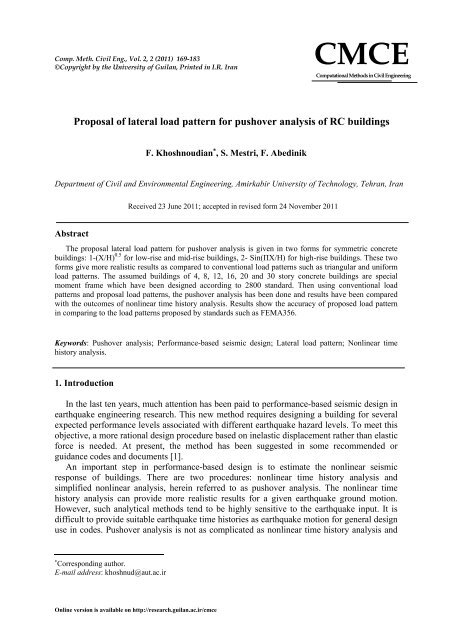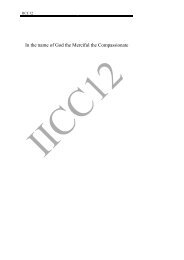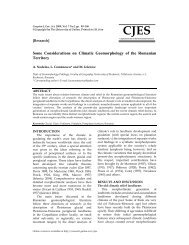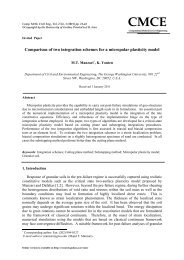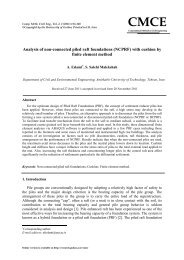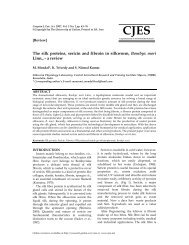Proposal of lateral load pattern for pushover analysis of RC buildings
Proposal of lateral load pattern for pushover analysis of RC buildings
Proposal of lateral load pattern for pushover analysis of RC buildings
You also want an ePaper? Increase the reach of your titles
YUMPU automatically turns print PDFs into web optimized ePapers that Google loves.
Comp. Meth. Civil Eng., Vol. 2, 2 (2011) 169-183<br />
©Copyright by the University <strong>of</strong> Guilan, Printed in I.R. Iran<br />
CMCE<br />
Computational Methods in Civil Engineering<br />
<strong>Proposal</strong> <strong>of</strong> <strong>lateral</strong> <strong>load</strong> <strong>pattern</strong> <strong>for</strong> <strong>pushover</strong> <strong>analysis</strong> <strong>of</strong> <strong>RC</strong> <strong>buildings</strong><br />
F. Khoshnoudian ∗ , S. Mestri, F. Abedinik<br />
Department <strong>of</strong> Civil and Environmental Engineering, Amirkabir University <strong>of</strong> Technology, Tehran, Iran<br />
Received 23 June 2011; accepted in revised <strong>for</strong>m 24 November 2011<br />
Abstract<br />
The proposal <strong>lateral</strong> <strong>load</strong> <strong>pattern</strong> <strong>for</strong> <strong>pushover</strong> <strong>analysis</strong> is given in two <strong>for</strong>ms <strong>for</strong> symmetric concrete<br />
<strong>buildings</strong>: 1-(X/H) 0.5 <strong>for</strong> low-rise and mid-rise <strong>buildings</strong>, 2- Sin(ΠX/H) <strong>for</strong> high-rise <strong>buildings</strong>. These two<br />
<strong>for</strong>ms give more realistic results as compared to conventional <strong>load</strong> <strong>pattern</strong>s such as triangular and uni<strong>for</strong>m<br />
<strong>load</strong> <strong>pattern</strong>s. The assumed <strong>buildings</strong> <strong>of</strong> 4, 8, 12, 16, 20 and 30 story concrete <strong>buildings</strong> are special<br />
moment frame which have been designed according to 2800 standard. Then using conventional <strong>load</strong><br />
<strong>pattern</strong>s and proposal <strong>load</strong> <strong>pattern</strong>s, the <strong>pushover</strong> <strong>analysis</strong> has been done and results have been compared<br />
with the outcomes <strong>of</strong> nonlinear time history <strong>analysis</strong>. Results show the accuracy <strong>of</strong> proposed <strong>load</strong> <strong>pattern</strong><br />
in comparing to the <strong>load</strong> <strong>pattern</strong>s proposed by standards such as FEMA356.<br />
Keywords: Pushover <strong>analysis</strong>; Per<strong>for</strong>mance-based seismic design; Lateral <strong>load</strong> <strong>pattern</strong>; Nonlinear time<br />
history <strong>analysis</strong>.<br />
1. Introduction<br />
In the last ten years, much attention has been paid to per<strong>for</strong>mance-based seismic design in<br />
earthquake engineering research. This new method requires designing a building <strong>for</strong> several<br />
expected per<strong>for</strong>mance levels associated with different earthquake hazard levels. To meet this<br />
objective, a more rational design procedure based on inelastic displacement rather than elastic<br />
<strong>for</strong>ce is needed. At present, the method has been suggested in some recommended or<br />
guidance codes and documents [1].<br />
An important step in per<strong>for</strong>mance-based design is to estimate the nonlinear seismic<br />
response <strong>of</strong> <strong>buildings</strong>. There are two procedures: nonlinear time history <strong>analysis</strong> and<br />
simplified nonlinear <strong>analysis</strong>, herein referred to as <strong>pushover</strong> <strong>analysis</strong>. The nonlinear time<br />
history <strong>analysis</strong> can provide more realistic results <strong>for</strong> a given earthquake ground motion.<br />
However, such analytical methods tend to be highly sensitive to the earthquake input. It is<br />
difficult to provide suitable earthquake time histories as earthquake motion <strong>for</strong> general design<br />
use in codes. Pushover <strong>analysis</strong> is not as complicated as nonlinear time history <strong>analysis</strong> and<br />
∗ Corresponding author.<br />
E-mail address: khoshnud@aut.ac.ir<br />
Online version is available on http://research.guilan.ac.ir/cmce
170<br />
F. Khoshnoudian, S. Mestri, F. Abedinik / Comp. Meth. Civil Eng., Vol. 2, 2 (2011) 169-183<br />
can use response spectrum as demand diagram to estimate the seismic response <strong>of</strong> structures<br />
[2]. There<strong>for</strong>e it is generally recommended in per<strong>for</strong>mance-based design.<br />
In <strong>pushover</strong> <strong>analysis</strong>, the first step is to suppose a certain <strong>lateral</strong> <strong>load</strong> <strong>pattern</strong>, then per<strong>for</strong>m<br />
a static <strong>analysis</strong> <strong>of</strong> the structural model under this <strong>pattern</strong>. The <strong>load</strong> <strong>pattern</strong> is applied step by<br />
step until a predetermined target displacement is reached. Thus, the relationship between base<br />
shear and ro<strong>of</strong> displacement is obtained, which is referred to as the capacity curve <strong>of</strong><br />
building. It is clear that different <strong>load</strong> <strong>pattern</strong>s will result in different capacity curves. If the<br />
curve over-or-underestimates the seismic capacity <strong>of</strong> the building, then the steps used to<br />
estimate the displacement response based on this curve and design demand diagram would<br />
not be realistic. There<strong>for</strong>e, the selection <strong>of</strong> a reasonable <strong>lateral</strong> <strong>load</strong> <strong>pattern</strong> is particularly<br />
important in <strong>pushover</strong> <strong>analysis</strong> [3].<br />
Several <strong>lateral</strong> <strong>load</strong> <strong>pattern</strong>s have been suggested. They are: (1) inverted triangle<br />
distribution (modal <strong>pattern</strong>); (2) uni<strong>for</strong>m distribution [4]; (3) <strong>load</strong> distribution based on linear<br />
elastic dynamic <strong>analysis</strong> or response spectrum <strong>analysis</strong> <strong>of</strong> the building [5]; (4) the adaptive<br />
distribution, which is varied as the inter story resistance changes in each <strong>load</strong> step [6]; (5)<br />
distribution proportional to the product <strong>of</strong> the mass and fundamental mode shape, which is<br />
used initially until the first yielding takes place. Then the <strong>lateral</strong> <strong>for</strong>ces are determined based<br />
on the product <strong>of</strong> the current floor displacement and mass at each step [7]; (6) a distribution<br />
based on mode shapes derived from secant stiffness at each <strong>load</strong> step [8]. The last three<br />
distributions are adaptive <strong>pattern</strong>s, which try to establish equivalent <strong>lateral</strong> <strong>load</strong> distribution<br />
based on a certain theoretical basis. However, their superiority over the simple fixed <strong>load</strong><br />
<strong>pattern</strong>s has not been demonstrated.<br />
It was also noted that the first two <strong>pattern</strong>s might result in the lower and upper bound <strong>of</strong><br />
<strong>pushover</strong> curves, respectively [9]. In present paper, numerous time history analyses are<br />
carried out <strong>for</strong> 4, 8, 12, 16, 20 and 30 story concrete <strong>buildings</strong>, which were selected to<br />
represent a variety <strong>of</strong> structures, to obtain the capacity curves <strong>of</strong> these <strong>buildings</strong> under<br />
earthquake excitations. Then, <strong>pushover</strong> analyses are conducted under different <strong>load</strong> <strong>pattern</strong>s<br />
including conventional and proposed <strong>load</strong> <strong>pattern</strong>s, the obtained capacity curves are<br />
compared with those obtained from time history <strong>analysis</strong>, the effectiveness <strong>of</strong> different <strong>load</strong><br />
<strong>pattern</strong>s is examined and suitable <strong>load</strong> <strong>pattern</strong>s are suggested <strong>for</strong> different types <strong>of</strong> structures.<br />
<strong>RC</strong> <strong>buildings</strong> have been designed according to Iranian earthquake standard. Then <strong>pushover</strong><br />
and nonlinear time history <strong>analysis</strong> are applied to each building by means <strong>of</strong> FEMA356.<br />
Pushover <strong>analysis</strong> is done by applying <strong>of</strong> triangular <strong>load</strong>, uni<strong>for</strong>m <strong>load</strong> as well as proposed<br />
<strong>load</strong> <strong>pattern</strong>s then the building capacity curve is drawn <strong>for</strong> each <strong>pattern</strong>. These curves are<br />
compared with those obtained from time history capacity <strong>of</strong> the building.<br />
The best <strong>lateral</strong> <strong>load</strong> <strong>pattern</strong> can be given by comparison <strong>of</strong> building’s capacity curve<br />
while applying <strong>of</strong> different <strong>lateral</strong> <strong>load</strong> <strong>pattern</strong>s with exact capacity curve obtained from time<br />
history nonlinear <strong>analysis</strong>.<br />
2. Introducing <strong>of</strong> records and <strong>buildings</strong><br />
2.1. Characteristics <strong>of</strong> <strong>buildings</strong><br />
The used design standards <strong>for</strong> 4, 8, 12, 16, 20, and 30-story <strong>buildings</strong> are introduced in this<br />
section. The <strong>load</strong> standard NO.6 <strong>of</strong> building national standard [10], Iranian seismic standard<br />
[11], and Iranian Concrete Regulation [12] have been used <strong>for</strong> design and <strong>analysis</strong> <strong>of</strong><br />
<strong>buildings</strong>. The height <strong>of</strong> each story has been assumed as 3 meters. Dead and live <strong>load</strong>s are<br />
supposed as 650 kg/m 2 and 200 kg/m 2 respectively. In addition, live <strong>load</strong> <strong>for</strong> the ro<strong>of</strong> is<br />
assumed 150 kg/m 2 . Lateral resisting system is considered special moment frame. Plan <strong>of</strong><br />
structures, based shear and type <strong>of</strong> the soil are presented in Figure 1 and Table 1 respectively.
F. Khoshnoudian, S. Mestri, F. Abedinik / Comp. Meth. Civil Eng., Vol. 2, 2 (2011) 169-183<br />
171<br />
Table 1. Characteristic <strong>of</strong> <strong>buildings</strong>.<br />
Story Soil C V (Ton)<br />
4<br />
8<br />
II<br />
II<br />
0.11<br />
0.08<br />
99.5<br />
142.3<br />
12 II 0.04 135.5<br />
16 II 0.04 214.7<br />
20 III 0.04 188.7<br />
30 II 0.02 259.7<br />
4-Story 20-Story 8, 12, 16 and 30-Story<br />
Figure 1. Plan <strong>of</strong> <strong>buildings</strong>.<br />
2.2. Used earthquakes<br />
Seven earthquake ground motions have been considered <strong>for</strong> each building. The<br />
characteristics and specifications <strong>of</strong> used records are in accordance with type <strong>of</strong> the soil. The<br />
specification <strong>of</strong> the used records is listed in Table 2. The spectrum relating to some used<br />
records is given in Figure 2. In this study, we assumed that the earthquake record does not<br />
affect the trend <strong>of</strong> the results obtained.<br />
3. Results<br />
3.1. Comparison <strong>of</strong> <strong>pushover</strong> and nonlinear time history <strong>analysis</strong><br />
In this section the capacity curve <strong>of</strong> conventional <strong>pushover</strong>, triangular and uni<strong>for</strong>m <strong>load</strong><br />
<strong>pattern</strong>s, and nonlinear time history <strong>analysis</strong> have been given. For extracting <strong>of</strong> building’s<br />
dynamic capacity curve, the nonlinear time history <strong>analysis</strong> should be carried out by multiply<br />
different coefficients to the earthquakes. After determining the response <strong>of</strong> nonlinear time<br />
history <strong>analysis</strong> <strong>for</strong> each used coefficient, the maximum displacement and base shear is<br />
extracted. There<strong>for</strong>e, it is obvious that <strong>for</strong> drawing <strong>of</strong> building’s dynamic capacity curve <strong>of</strong> a<br />
record, different nonlinear time history <strong>analysis</strong> should be per<strong>for</strong>med. Each point <strong>of</strong> capacity<br />
curve can be obtained by per<strong>for</strong>ming a nonlinear time history <strong>analysis</strong> using a ground motion<br />
record. The dynamic capacity curves obtained from mentioned records are shown in Figure 3.
172<br />
F. Khoshnoudian, S. Mestri, F. Abedinik / Comp. Meth. Civil Eng., Vol. 2, 2 (2011) 169-183<br />
Table 2. Characteristics <strong>of</strong> used records [13].<br />
abbreviations Name <strong>of</strong> records Date Station<br />
Soil<br />
type<br />
PGA (g)<br />
LADSP Landers 06/28/92 Desert hot springs B 0.171<br />
LPAND Loma prieta 10/18/89 Anderson dam downstream B 0.242<br />
LPGIL Loma prieta 10/18/89 Gilroy gavilan coll B 0.357<br />
LPSTG Loma prieta 10/18/89 Saratoga aloha ave B 0.512<br />
MHGO Morgan hill 04/24/84 Gilroy array B 0.355<br />
NRORR Northridge 01/17/94 Castaic old ridge rt B 0.514<br />
IPLVY Imperial valley 5/19/40 El centro array B 0.308<br />
TABAS Tabas 09/16/78 Tabas B 0.836<br />
KOBE Kobe 01/16/95 Takarazu B 0.689<br />
MENDOCINO Cape mendocino 04/25/92 Cape mendocino B 0.494<br />
NORTHRIDGE Northridge 01/17/94 Rinaldi receiving sta C 0.838<br />
IMPERIAL<br />
VALLEY<br />
Imperial valley 5/19/40 El centro array #9 C 0.308<br />
LOMA PRIETA Loma prieta 10/18/89 Capitola C 0.442<br />
MENDOCINO Cape mendocino 04/25/92 Petrolia C 0.662<br />
MORGAN<br />
HILL<br />
Morgan hill 04/24/84 Gilroy array #2 C 0.212<br />
HOLLISTER Hollister 11/28/74 Hollister city hall C 0.175<br />
TURKEY Turkey 11/12/99 Duzce C 0.535<br />
1<br />
LPAND<br />
0.8<br />
LADSP<br />
Response Acceleration (g)<br />
0.75<br />
0.5<br />
0.25<br />
Response Acceleration (g)<br />
0.6<br />
0.4<br />
0.2<br />
0<br />
0 1 2 3 4<br />
Period (sec)<br />
0<br />
0 1 2 3 4<br />
Period (sec)<br />
1.2<br />
LPGIL<br />
1.2<br />
LPSTG<br />
Response Acceleration (g)<br />
0.8<br />
0.4<br />
Response Acceleration (g)<br />
0.8<br />
0.4<br />
0<br />
0 1 2 3 4<br />
Period (sec)<br />
0<br />
0 1 2 3 4<br />
Period (sec)<br />
Figure 2. Response spectra <strong>of</strong> some records.
F. Khoshnoudian, S. Mestri, F. Abedinik / Comp. Meth. Civil Eng., Vol. 2, 2 (2011) 169-183<br />
173<br />
Base Shear (Ton)<br />
Base Shear (Ton)<br />
In this research, dynamic capacity curves have been drawn under seven earthquakes as<br />
well as average capacity curve, amongst these seven dynamic capacity curves, which is called<br />
the real capacity curve <strong>of</strong> building, is extracted. The capacity curve obtained from triangular<br />
and uni<strong>for</strong>m <strong>load</strong> <strong>pattern</strong>s is evaluated by comparing to real capacity curve <strong>of</strong> each building<br />
(Figure 4).<br />
250<br />
200<br />
150<br />
100<br />
50<br />
0<br />
800<br />
700<br />
600<br />
500<br />
400<br />
300<br />
200<br />
100<br />
0<br />
LADSP<br />
LPGIL<br />
MHGO<br />
IPLVY<br />
LPAND<br />
LPSTG<br />
NORR<br />
AVERAGE<br />
0 5 10 15 20 25<br />
Ro<strong>of</strong> Displacement (cm)<br />
Base Shear (Ton)<br />
450<br />
400<br />
350<br />
300<br />
250<br />
200<br />
150<br />
100<br />
50<br />
0<br />
0 10 20 30 40<br />
Ro<strong>of</strong> Displacement (cm)<br />
(a) 4-Story (b) 8-Story (b) 12-Story<br />
LADSP<br />
LPGIL<br />
MHGO<br />
Valley<br />
LPAND<br />
LPSTG<br />
Northridge<br />
AVERAGE<br />
0 10 20 30 40 50 60<br />
Ro<strong>of</strong> Displacement (cm)<br />
Base Shear (Ton)<br />
700<br />
600<br />
500<br />
400<br />
300<br />
200<br />
100<br />
0<br />
(d) 16-Story (e) 20-Story (f) 30-Story<br />
Figure 3. Dynamic capacity curves <strong>of</strong> <strong>buildings</strong>.<br />
LADSP<br />
LPGIL<br />
MHGO<br />
IPLVY<br />
Loma Prieta<br />
Torkey<br />
Elcentro<br />
Hollister<br />
LPAND<br />
LPSTG<br />
NORR<br />
AVERAGE<br />
Morgan Hill<br />
Northridge<br />
Mendocino<br />
AVERAGE<br />
0 10 20 30 40<br />
Ro<strong>of</strong> Displacement (cm)<br />
Base Shear (Ton)<br />
Base Shear (Ton)<br />
450<br />
400<br />
350<br />
300<br />
250<br />
200<br />
150<br />
100<br />
50<br />
0<br />
1200<br />
1000<br />
800<br />
600<br />
400<br />
200<br />
0<br />
Mendocino<br />
Tabas<br />
MHGO<br />
IPLVY<br />
Kobe<br />
LPSTG<br />
NORR<br />
AVERAGE<br />
0 20 40 60 80 100<br />
Ro<strong>of</strong> Displacement (cm)<br />
LADSP<br />
LPGIL<br />
MHGO<br />
IPLVY<br />
LPAND<br />
LPSTG<br />
NORR<br />
AVERAGE<br />
0 20 40 60 80 100<br />
Ro<strong>of</strong> Displacement (cm)<br />
Considering the previous figure, the error induced by using conventional <strong>load</strong> <strong>pattern</strong><br />
instead <strong>of</strong> nonlinear time history <strong>analysis</strong> is demonstrated.<br />
The dynamic capacity curve is located between two capacity curves obtained from<br />
uni<strong>for</strong>m and triangular <strong>load</strong> <strong>pattern</strong>s <strong>for</strong> both 4 and 8-story <strong>buildings</strong>. In 12, 16, 20 and 30<br />
story <strong>buildings</strong> the dynamic capacity curve is located above the two mentioned capacity<br />
curves. With regard to these graphs, using the uni<strong>for</strong>m <strong>load</strong> <strong>pattern</strong> is unsuitable <strong>for</strong> low-rise<br />
<strong>buildings</strong> at all as it overestimates the capacity <strong>of</strong> the building from its real capacity. Using<br />
this <strong>load</strong> <strong>pattern</strong> <strong>for</strong> high-rise <strong>buildings</strong> would lead to a considerable error. Especially 30<br />
story building in contrast to uni<strong>for</strong>m <strong>load</strong> <strong>pattern</strong> the triangular <strong>load</strong> <strong>pattern</strong> is more reliable<br />
as it always underestimates the capacity <strong>of</strong> building from its real capacity. There<strong>for</strong>e, using a<br />
new <strong>load</strong> <strong>pattern</strong> which gives a more realistic view can result in a more economic design.
174<br />
F. Khoshnoudian, S. Mestri, F. Abedinik / Comp. Meth. Civil Eng., Vol. 2, 2 (2011) 169-183<br />
300<br />
350<br />
250<br />
300<br />
Base Shear (Ton)<br />
200<br />
150<br />
100<br />
50<br />
Uni<strong>for</strong>m<br />
Triangular<br />
Average<br />
Base Shear (Ton)<br />
250<br />
200<br />
150<br />
100<br />
50<br />
Uni<strong>for</strong>m<br />
Triangular<br />
Average<br />
0<br />
400<br />
0 5 10 15 20<br />
Ro<strong>of</strong> Displacement (cm)<br />
(a) 4-Story<br />
0<br />
700<br />
0 5 10 15 20 25 30 35<br />
Ro<strong>of</strong> Displacement (cm)<br />
(b) 8-Story<br />
Base Shear (Ton)<br />
350<br />
300<br />
250<br />
200<br />
150<br />
100<br />
50<br />
Uni<strong>for</strong>m<br />
Triangular<br />
Average<br />
Base Shear (Ton)<br />
600<br />
500<br />
400<br />
300<br />
200<br />
100<br />
Uni<strong>for</strong>m<br />
Triangular<br />
Average<br />
Base Shear (Ton)<br />
0<br />
600<br />
500<br />
400<br />
300<br />
200<br />
100<br />
0<br />
0 10 20 30 40 50 60<br />
Ro<strong>of</strong> Displacement (cm)<br />
(c) 12-Story<br />
Uni<strong>for</strong>m<br />
Triangular<br />
Average<br />
0 10 20 30 40 50<br />
Ro<strong>of</strong> Displacement (cm)<br />
(e) 20-Story<br />
Base Shear (Ton)<br />
0<br />
900<br />
800<br />
700<br />
600<br />
500<br />
400<br />
300<br />
200<br />
100<br />
0<br />
0 10 20 30 40 50 60<br />
Ro<strong>of</strong> Displacement (cm)<br />
(d) 16-Story<br />
Uni<strong>for</strong>m<br />
Triangular<br />
Average<br />
0 20 40 60 80 100<br />
Ro<strong>of</strong> Displacement (cm)<br />
(f) 30-Story<br />
Figure 4. Comparison <strong>of</strong> dynamic capacity curve with triangular and uni<strong>for</strong>m capacity curves.<br />
3.2. New proposed <strong>load</strong> <strong>pattern</strong>s<br />
Different mathematical functions as a <strong>load</strong> <strong>pattern</strong> can be used <strong>for</strong> paving the way to be<br />
closer to real capacity curve. Then the best <strong>load</strong> <strong>pattern</strong> can be obtained by comparing the<br />
building capacity curve under the suggested applied <strong>pattern</strong>s and the real capacity curve.
F. Khoshnoudian, S. Mestri, F. Abedinik / Comp. Meth. Civil Eng., Vol. 2, 2 (2011) 169-183<br />
175<br />
Figure 5. <strong>Proposal</strong> <strong>load</strong> <strong>pattern</strong>s.
176<br />
F. Khoshnoudian, S. Mestri, F. Abedinik / Comp. Meth. Civil Eng., Vol. 2, 2 (2011) 169-183<br />
In this investigation, many different <strong>load</strong> <strong>pattern</strong>s have been applied to the <strong>buildings</strong> by<br />
means <strong>of</strong> different mathematical functions. Some <strong>of</strong> the applied <strong>pattern</strong>s are exhibited in<br />
Figure 5. It is obvious that each <strong>load</strong> <strong>pattern</strong> gives different capacity curve as compared with<br />
other presented <strong>pattern</strong>s. By drawing the capacity curve <strong>for</strong> each <strong>load</strong> <strong>pattern</strong> and comparing<br />
it with dynamic capacity curve, the important factor is the center <strong>of</strong> the <strong>load</strong> <strong>pattern</strong> which is<br />
the contact point <strong>of</strong> the applied <strong>lateral</strong> <strong>load</strong> resultant under the same <strong>pattern</strong> (X). The applied<br />
<strong>pattern</strong>s to 4 and 8–story <strong>buildings</strong> are as follows:<br />
1- ( X/H) 0.5 5- Tan( ПX/4H)<br />
2- ( X/H) 2 6- Sin( ПX/2H)<br />
3- ( X/H) 3 7- Tri + Uni<br />
4- ( X/H) 4 8- Sin( ПX/H)<br />
3.2.1. Capacity curves<br />
The capacity curve corresponding to the above <strong>load</strong> <strong>pattern</strong>s <strong>for</strong> 4 and 8 -story <strong>buildings</strong><br />
are illustrated in Figure 6a and Figure 6b in the same order.<br />
Considering this figure, the capacity curves obtained from <strong>load</strong> <strong>pattern</strong>s 2 to 5 are located<br />
under the capacity curve <strong>of</strong> triangular <strong>load</strong> <strong>pattern</strong>. Beside it, the capacity curves<br />
corresponding to <strong>load</strong> <strong>pattern</strong>s 6, 1, and 7 are located between two capacity curves <strong>of</strong><br />
triangular and uni<strong>for</strong>m <strong>load</strong> <strong>pattern</strong>s.<br />
Keeping in mind the factor mentioned in previous section it is apprehended that the value<br />
<strong>of</strong> X <strong>for</strong> <strong>pattern</strong>s 2 to 5 is more than the value <strong>of</strong> X <strong>for</strong> triangular <strong>pattern</strong>s.<br />
In the same way, the value <strong>of</strong> X <strong>for</strong> <strong>load</strong> <strong>pattern</strong>s 1, 6 and 7 is located between this value<br />
<strong>for</strong> triangular and uni<strong>for</strong>m <strong>load</strong> <strong>pattern</strong>s.<br />
250<br />
350<br />
200<br />
300<br />
250<br />
Base Shear (Ton)<br />
150<br />
100<br />
Uni<strong>for</strong>m<br />
Tri+Uni<br />
(X/12)^0.5 Triangular<br />
50<br />
Tan(πX/48) (X/12)^2<br />
(X/12)^3 Sin(πX/24)<br />
Average<br />
0<br />
0 5 10 15 20 25<br />
Ro<strong>of</strong> Displacement (cm)<br />
Base Shear (Ton)<br />
200<br />
150<br />
Uni<strong>for</strong>m<br />
Tri+Uni<br />
100<br />
(X/24)^0.5 Triangular<br />
Tan(πX/96) (X/24)^2<br />
50<br />
(X/24)^3 Sin(πX/48)<br />
Average<br />
0<br />
0 5 10 15 20 25 30 35<br />
Ro<strong>of</strong> Displacement (cm)<br />
(a) 4-Story<br />
(b) 8-Story<br />
Figure 6. Various obtained capacity curves.<br />
We come to conclusion that the higher value <strong>of</strong> X (point <strong>of</strong> <strong>lateral</strong> <strong>load</strong> resultant), the<br />
lower the position <strong>of</strong> its capacity curves on the scale. On the other hand, the lower the contact<br />
point <strong>of</strong> <strong>lateral</strong> <strong>load</strong> resultant in a <strong>load</strong> <strong>pattern</strong>, the higher position <strong>of</strong> its curve on the scale. To<br />
determine the best <strong>lateral</strong> <strong>load</strong> <strong>pattern</strong>, the time history capacity curve or real capacity curve<br />
<strong>of</strong> the building is used. According to Figure 7, the <strong>load</strong> <strong>pattern</strong>s (X/H) 0.5 and Tri+Uni show<br />
the best accordance to the real capacity curve <strong>of</strong> the building.
F. Khoshnoudian, S. Mestri, F. Abedinik / Comp. Meth. Civil Eng., Vol. 2, 2 (2011) 169-183<br />
177<br />
250<br />
350<br />
200<br />
300<br />
250<br />
Base Shear (Ton)<br />
150<br />
100<br />
50<br />
Tri+Uni<br />
(X/12)^0.5<br />
Average<br />
Base Shear (Ton)<br />
200<br />
150<br />
100<br />
50<br />
Tri+Uni<br />
(X/24)^0.5<br />
Average<br />
0<br />
0 5 10 15 20 25<br />
0<br />
0 5 10 15 20 25 30 35<br />
Ro<strong>of</strong> Displacement (cm)<br />
Ro<strong>of</strong> Displacement (cm)<br />
(a) 4-Story<br />
(b) 8-Story<br />
Figure 7. Capacity curves corresponding to proposed <strong>load</strong> <strong>pattern</strong>s.<br />
According to the Figure 4 the capacity curves <strong>of</strong> high-rise <strong>buildings</strong> are located in higher<br />
position with comparing to uni<strong>for</strong>m and triangular capacity curves. It is confirmed that using<br />
uni<strong>for</strong>m <strong>load</strong> <strong>pattern</strong> <strong>for</strong> high-rise <strong>buildings</strong> shows accurate results as compared with<br />
triangular <strong>load</strong> <strong>pattern</strong>. There<strong>for</strong>e, it is better to convert the <strong>lateral</strong> <strong>load</strong> distribution <strong>pattern</strong><br />
from triangular to uni<strong>for</strong>m by increasing the height <strong>of</strong> the building.<br />
Achieving new <strong>lateral</strong> <strong>load</strong> <strong>pattern</strong>s <strong>for</strong> high-rise <strong>buildings</strong>, with regard to the represented<br />
solution <strong>for</strong> 4-story building in the previous section, we should use <strong>pattern</strong>s the <strong>lateral</strong> <strong>load</strong><br />
resultant's contact point is located in lower height as compared with uni<strong>for</strong>m <strong>load</strong> <strong>pattern</strong>. As<br />
a result, the <strong>load</strong> <strong>pattern</strong>s in Figure 8 are used <strong>for</strong> tall <strong>buildings</strong>. The capacity curves <strong>of</strong><br />
proposed <strong>load</strong> <strong>pattern</strong>s are shown in Figure 9.<br />
Figure 8. Applied <strong>load</strong> <strong>pattern</strong>s to tall building.
178<br />
F. Khoshnoudian, S. Mestri, F. Abedinik / Comp. Meth. Civil Eng., Vol. 2, 2 (2011) 169-183<br />
450<br />
700<br />
Base Shear (Ton)<br />
400<br />
350<br />
300<br />
250<br />
200<br />
150<br />
LP‐1<br />
LP‐2<br />
100<br />
Uni<strong>for</strong>m<br />
Tri+Uni<br />
(X/36)^0.5 Triangular<br />
50<br />
Sin(πX/36) Average<br />
0<br />
0 10 20 30 40 50 60<br />
Base Shear (Ton)<br />
600<br />
500<br />
400<br />
300<br />
200<br />
LP‐1<br />
LP‐2<br />
Uni<strong>for</strong>m<br />
Tri+Uni<br />
100<br />
(X/48)^0.5 Triangular<br />
Sin(πX/48) Average<br />
0<br />
0 10 20 30 40 50 60<br />
Ro<strong>of</strong> Displacement (cm)<br />
Ro<strong>of</strong> Displacement (cm)<br />
(a) 12-Story<br />
(b) 16-Story<br />
700<br />
900<br />
600<br />
800<br />
Base Shear (Ton)<br />
500<br />
400<br />
300<br />
200<br />
LP‐1<br />
LP‐2<br />
Uni<strong>for</strong>m<br />
Tri+Uni<br />
100<br />
(X/60)^0.5 Triangular<br />
Sin(πX/60) Average<br />
0<br />
0 10 20 30 40 50<br />
Base Shear (Ton)<br />
700<br />
600<br />
500<br />
400<br />
300<br />
LP‐1<br />
LP‐2<br />
200<br />
Uni<strong>for</strong>m<br />
Tri+Uni<br />
100<br />
(X/90)^0.5 Triangular<br />
Sin(πX/90) Average<br />
0<br />
0 20 40 60 80 100<br />
Ro<strong>of</strong> Displacement (cm)<br />
Ro<strong>of</strong> Displacement (cm)<br />
(c) 20-Story<br />
(d) 30-Story<br />
Figure 9. Various capacity curves obtained <strong>for</strong> tall building.<br />
The dynamic capacity curve, real capacity curve, is utilized to determine the best <strong>lateral</strong><br />
<strong>load</strong> <strong>pattern</strong>. According to Figure 10, the proposed <strong>load</strong> <strong>pattern</strong>s 1 and Sin(ΠX/H) along with<br />
uni<strong>for</strong>m <strong>load</strong> <strong>pattern</strong> get the best capacity curves <strong>for</strong> 12 and 16-story <strong>buildings</strong>. It is obvious<br />
that <strong>for</strong> 20-story building the capacity curve <strong>of</strong> uni<strong>for</strong>m <strong>pattern</strong> presents inappropriate<br />
response <strong>of</strong> building, while the curves relating to proposed <strong>pattern</strong>s 1 and 2 merely close to<br />
dynamic capacity curve.<br />
450<br />
700<br />
Base Shear (Ton)<br />
400<br />
350<br />
300<br />
250<br />
200<br />
150<br />
LP‐1<br />
100<br />
Uni<strong>for</strong>m<br />
Sin(πX/36)<br />
50<br />
Average<br />
0<br />
0 10 20 30 40 50 60<br />
Base Shear (Ton)<br />
600<br />
500<br />
400<br />
300<br />
LP‐1<br />
200<br />
Uni<strong>for</strong>m<br />
100<br />
Sin(πX/48)<br />
Average<br />
0<br />
0 10 20 30 40 50 60<br />
Ro<strong>of</strong> Displacement (cm)<br />
Ro<strong>of</strong> Displacement (cm)<br />
(a) 12-Story<br />
(b) 16-Story<br />
Figure 10. Comparison <strong>of</strong> dynamic capacity curves <strong>of</strong> the proposed <strong>load</strong> <strong>pattern</strong>s.
F. Khoshnoudian, S. Mestri, F. Abedinik / Comp. Meth. Civil Eng., Vol. 2, 2 (2011) 169-183<br />
179<br />
According to Figure 11(b) the <strong>pattern</strong>s 1 and 2 exhibit better behavior <strong>for</strong> 30-story<br />
building. However; there is still a considerable difference between its capacity curve and the<br />
dynamic capacity curve. This difference is due to higher modes effects. This would lead to<br />
significant error in results <strong>of</strong> <strong>pushover</strong> <strong>analysis</strong> comparing to nonlinear time history <strong>analysis</strong><br />
as the number <strong>of</strong> stories increase.<br />
700<br />
900<br />
600<br />
800<br />
Base Shear (Ton)<br />
500<br />
400<br />
300<br />
200<br />
LP‐1<br />
LP‐2<br />
100<br />
Sin(πX/60)<br />
Average<br />
0<br />
0 10 20 30 40 50<br />
Base Shear (Ton)<br />
700<br />
600<br />
500<br />
400<br />
300<br />
LP‐1<br />
200<br />
LP‐2<br />
100<br />
Sin(πX/90)<br />
Average<br />
0<br />
0 20 40 60 80 100<br />
Ro<strong>of</strong> Displacement (cm)<br />
Ro<strong>of</strong> Displacement (cm)<br />
(a) 20-Story<br />
(b) 30-Story<br />
Figure 11. Comparison <strong>of</strong> capacity curves obtained from proposed and the real capacity curve.<br />
3.2.2. Per<strong>for</strong>mance points<br />
For better verification <strong>of</strong> proposed <strong>lateral</strong> <strong>load</strong> <strong>pattern</strong>s, per<strong>for</strong>mance point <strong>of</strong> the <strong>buildings</strong><br />
under the proposed <strong>load</strong> <strong>pattern</strong>s is obtained and compares them with the average <strong>of</strong><br />
maximum nonlinear dynamic displacement (Figure 12).<br />
It is noted that he per<strong>for</strong>mance point was obtained with intersection <strong>of</strong> capacity curve and<br />
demand spectrum as explained in FEMA 356 document.<br />
This figure illustrates that not only capacity curve is influenced highly by different <strong>lateral</strong><br />
<strong>load</strong> distribution but also the per<strong>for</strong>mance point is affected in the same way. There<strong>for</strong>e, the<br />
responses <strong>of</strong> building including capacity curve and per<strong>for</strong>mance point are significantly<br />
depended on the <strong>lateral</strong> <strong>load</strong> <strong>pattern</strong>.<br />
Two proposed <strong>load</strong> <strong>pattern</strong>s Tri+Uni and √(X/H) show better accuracy than triangular <strong>load</strong><br />
<strong>pattern</strong> in estimating the per<strong>for</strong>mance point <strong>for</strong> both 4-story and 8-story <strong>buildings</strong>. There<strong>for</strong>e,<br />
applying these two <strong>pattern</strong>s is appropriate <strong>for</strong> determining the per<strong>for</strong>mance point <strong>of</strong> low-rise<br />
and mid-rise <strong>buildings</strong>. Proposed <strong>load</strong> <strong>pattern</strong> Sin (ΠX/H) is the most precise <strong>load</strong> <strong>pattern</strong> to<br />
determine the per<strong>for</strong>mance point <strong>of</strong> a 16-story building as compared with other <strong>pattern</strong>s. But<br />
it is unsuitable <strong>for</strong> determining the per<strong>for</strong>mance point <strong>of</strong> 12-story building. For determining<br />
the per<strong>for</strong>mance point <strong>of</strong> 20-story and 30-story <strong>buildings</strong> the <strong>load</strong> <strong>pattern</strong> 2 exhibits the most<br />
accurate result among other <strong>load</strong> <strong>pattern</strong>s.
180<br />
F. Khoshnoudian, S. Mestri, F. Abedinik / Comp. Meth. Civil Eng., Vol. 2, 2 (2011) 169-183<br />
200<br />
350<br />
180<br />
160<br />
300<br />
260<br />
300<br />
140<br />
120<br />
Unif orm Triangle (X/12)^0.5<br />
Tri+Uni Average<br />
100<br />
9 9.5 10 10.5 11<br />
500<br />
D (cm)<br />
(a) 4-Story<br />
220<br />
Unif orm Triangle<br />
(X/24)^0.5 Tri+Uni<br />
Average<br />
180<br />
15 17 19 21 23<br />
450<br />
D (cm)<br />
(b) 8-Story<br />
250<br />
Uni<strong>for</strong>m Triangle (X/36)^0.5<br />
Tri+Uni Sin(ΠX/36) Average<br />
200<br />
22 24 26 28 30<br />
600<br />
D (cm)<br />
(c) 12-Story<br />
400<br />
400<br />
350<br />
500<br />
300<br />
Unif orm Triangle (X/48)^0.5<br />
Tri+Uni Sin(ΠX/48) Average<br />
200<br />
20 25 30 35<br />
D (cm)<br />
(d) 16-Story<br />
300<br />
250<br />
Unif orm Triangle Pattern 2<br />
(X/60)^0.5 Tri+Uni Average<br />
200<br />
30 32 34 36 38 40<br />
D (cm)<br />
(e) 20-Story<br />
400<br />
Uni<strong>for</strong>m Triangle (X90)^0.5<br />
Tri+Uni Pattern 2 Average<br />
300<br />
30 35 40 45 50 55 60<br />
D (cm)<br />
(f) 30-Story<br />
Figure 12. Verification <strong>of</strong> per<strong>for</strong>mance points (vertical axis is base shear (ton)).<br />
3.2.3. Verification <strong>of</strong> displacement criterion<br />
One <strong>of</strong> the parameter <strong>for</strong> verification <strong>of</strong> per<strong>for</strong>mance levels <strong>of</strong> <strong>buildings</strong> is to determine<br />
story drift <strong>of</strong> <strong>buildings</strong>. Figure 13 presents drift <strong>of</strong> various <strong>buildings</strong> using different <strong>load</strong><br />
<strong>pattern</strong>s and time history <strong>analysis</strong> as an exact solution.<br />
For this purpose, the values <strong>of</strong> relative displacements <strong>of</strong> the <strong>buildings</strong> at per<strong>for</strong>mance point<br />
are obtained and compared to them with the results obtained from nonlinear time history<br />
<strong>analysis</strong> (Figure 13).<br />
The figure shows how various <strong>load</strong> <strong>pattern</strong>s can induce different drifts and result various<br />
per<strong>for</strong>mance levels. In addition, the accuracy <strong>of</strong> proposed <strong>load</strong> <strong>pattern</strong>s can be approved by<br />
comparing to the nonlinear time history <strong>analysis</strong>, regarding to the per<strong>for</strong>mance levels.
F. Khoshnoudian, S. Mestri, F. Abedinik / Comp. Meth. Civil Eng., Vol. 2, 2 (2011) 169-183<br />
181<br />
Figure 13. Verification <strong>of</strong> per<strong>for</strong>mance levels.<br />
4. Conclusion<br />
In the current paper, new <strong>load</strong> <strong>pattern</strong>s <strong>for</strong> symmetrical rein<strong>for</strong>ced concrete <strong>buildings</strong> have<br />
been proposed. Numerous <strong>pushover</strong> <strong>analysis</strong> using conventional <strong>load</strong> <strong>pattern</strong>s and proposed<br />
<strong>load</strong> <strong>pattern</strong>s as well as nonlinear time history <strong>analysis</strong> as an exact solution were per<strong>for</strong>med.<br />
The obtained results can be summarized as follows:<br />
1. It is inappropriate to use uni<strong>for</strong>m <strong>load</strong> <strong>pattern</strong> <strong>for</strong> determining the capacity curve <strong>of</strong><br />
low-rise and mid-rise <strong>buildings</strong>. The capacity curve obtained from uni<strong>for</strong>m <strong>load</strong><br />
<strong>pattern</strong> is located higher than it corresponding to dynamic capacity curve and<br />
there<strong>for</strong>e it is not reliable. The reliable <strong>pattern</strong> is triangular <strong>load</strong> <strong>pattern</strong> as it<br />
underestimates the capacity <strong>of</strong> the building. On the other hand the triangular <strong>load</strong><br />
<strong>pattern</strong> does not show the real capacity <strong>of</strong> the building and it is not economic too.<br />
Using two proposed <strong>load</strong> <strong>pattern</strong>s √(X/H) and componential <strong>pattern</strong> Tri+Uni (which
182<br />
F. Khoshnoudian, S. Mestri, F. Abedinik / Comp. Meth. Civil Eng., Vol. 2, 2 (2011) 169-183<br />
is a combination <strong>of</strong> triangular and uni<strong>for</strong>m <strong>pattern</strong>s) removes the mentioned shortcoming<br />
and gives a precise capacity <strong>of</strong> the building.<br />
2. Applying triangular <strong>load</strong> <strong>pattern</strong> would lead to significant errors in capacity curve as<br />
the height increases. It underestimates the capacity <strong>of</strong> the building. The uni<strong>for</strong>m <strong>load</strong><br />
<strong>pattern</strong> gives better results <strong>for</strong> mid-rise building. The capacity curve obtained from<br />
uni<strong>for</strong>m <strong>load</strong> <strong>pattern</strong> differs slightly from dynamic capacity <strong>of</strong> the building. Applying<br />
this <strong>pattern</strong> <strong>for</strong> high-rise <strong>buildings</strong> is more realistic. In addition, the proposed <strong>load</strong><br />
<strong>pattern</strong> 2 gives accurate capacity curve, as a result, proposal <strong>load</strong> <strong>pattern</strong> is even better<br />
than uni<strong>for</strong>m <strong>load</strong> <strong>pattern</strong> according to obtained results <strong>for</strong> 20 and 30-story <strong>buildings</strong>.<br />
There are two other proposed <strong>load</strong> <strong>pattern</strong>s Tri+Uni and (X/H) 0.5 which could improve<br />
the results as compared with triangular <strong>load</strong> <strong>pattern</strong> and the curves obtained from the<br />
two <strong>pattern</strong>s are more precise than capacity curve <strong>of</strong> triangular <strong>load</strong> <strong>pattern</strong>.<br />
3. Load <strong>pattern</strong> Sin(ΠX/H) <strong>for</strong> 12 and 16-story <strong>buildings</strong> is more accurate than it<br />
corresponding to triangular and uni<strong>for</strong>m <strong>load</strong> <strong>pattern</strong>s. For 20-story building, the<br />
proposed <strong>lateral</strong> <strong>load</strong> <strong>pattern</strong> number 2 shows the least error in determining the<br />
capacity curve <strong>of</strong> building. There<strong>for</strong>e, the proposed <strong>pattern</strong> <strong>for</strong> 12 and 16-story<br />
<strong>buildings</strong> is Sin(ΠX/H) and <strong>for</strong> 20-story, <strong>load</strong> <strong>pattern</strong> number 2 is suggested.<br />
4. The shortcoming <strong>of</strong> all <strong>load</strong> <strong>pattern</strong>s <strong>for</strong> determining <strong>of</strong> the capacity curve <strong>of</strong> 30-story<br />
building is demonstrated. Although the proposed <strong>pattern</strong> 2 has improved the condition<br />
in some extends, none <strong>of</strong> the proposed and existing <strong>load</strong> <strong>pattern</strong>s represent an<br />
appropriate estimation <strong>of</strong> the building capacity curve. It is due to increasing <strong>of</strong><br />
participation <strong>of</strong> higher modes and weakness <strong>of</strong> existing <strong>load</strong> <strong>pattern</strong>s.<br />
5. In high-rise <strong>buildings</strong>, be<strong>for</strong>e <strong>for</strong>mation <strong>of</strong> the plastic hinges on the upper stories the<br />
hinges in lower stories turn to life safety (LS) and even collapse prevention (CP). That<br />
is the reason <strong>for</strong> differences between <strong>pushover</strong> capacity curve and dynamic capacity<br />
curve <strong>for</strong> high-rise <strong>buildings</strong>. It means that in <strong>pushover</strong> <strong>analysis</strong> <strong>of</strong> high-rise <strong>buildings</strong><br />
the capacity <strong>of</strong> the upper stories is not considered. By using particular <strong>load</strong> <strong>pattern</strong>s in<br />
which the direction <strong>of</strong> the <strong>lateral</strong> <strong>load</strong>s changes, the necessary drift <strong>for</strong> <strong>for</strong>mation <strong>of</strong><br />
plastic hinges in upper stories is provided. Overall, a <strong>load</strong> <strong>pattern</strong> which can apply the<br />
influence <strong>of</strong> different modes to the building, can give more reliable results.<br />
6. Comparing dynamic maximum displacement with per<strong>for</strong>mance point, we find that<br />
different <strong>load</strong> <strong>pattern</strong>s overestimate the results <strong>of</strong> <strong>pushover</strong> <strong>analysis</strong>. We should keep<br />
in mind that the records used in nonlinear time history <strong>analysis</strong> highly affect the<br />
determination <strong>of</strong> maximum displacement.<br />
In this study we assumed the earthquake record does not affect the trend <strong>of</strong> the results<br />
obtained, further studies are needed to demonstrate the effects <strong>of</strong> different earthquakes with<br />
various sources such as far field and near field (with fling step or <strong>for</strong>ward directivity) on the<br />
<strong>lateral</strong> <strong>load</strong> <strong>pattern</strong>s.<br />
References<br />
[1] Structural Engineers Association <strong>of</strong> Cali<strong>for</strong>nia, SEAOC, Per<strong>for</strong>mance Based Seismic Engineering <strong>of</strong><br />
Buildings, Version 2000, Sacramento, Cali<strong>for</strong>nia, 1995.
F. Khoshnoudian, S. Mestri, F. Abedinik / Comp. Meth. Civil Eng., Vol. 2, 2 (2011) 169-183<br />
183<br />
[2] A.K. Chopra, R.K. Goel, Capacity-Demand-Diagram method <strong>for</strong> estimating seismic de<strong>for</strong>mation <strong>of</strong><br />
inelastic structure: SDF system, Report PEER-1992/02, Pacific Engineering Research Center, College <strong>of</strong><br />
Engineering , University <strong>of</strong> Cali<strong>for</strong>nia , Berkeley, 1999.<br />
[3] S. Jingjiang, T. Ono, Z. Yangang, W. Wei, Lateral <strong>load</strong> <strong>pattern</strong> in <strong>pushover</strong> <strong>analysis</strong>, Earthquake<br />
Engineering And Engineering Vibration, Vol. 2, 1 (2003) 99-107.<br />
[4] Applied Technology Council, Prestandard and Commentary <strong>for</strong> the Seismic Rehabilitation <strong>of</strong> Buildings<br />
(FEMA356), 2000.<br />
[5] W.K. Tso, A.S. Moghadam, Seismic response <strong>of</strong> asymmetric <strong>buildings</strong> using <strong>pushover</strong> <strong>analysis</strong>,<br />
Proceedings Workshop on Seismic Design Methodologies <strong>for</strong> the Next Generation <strong>of</strong> codes, Bled,<br />
Slovenia, Rotterdam, Balkema, (1997).<br />
[6] J.M. Bracci, S.K. Kunnath, A.M. Reinhorn, Seismic per<strong>for</strong>mance and retr<strong>of</strong>it evaluation <strong>of</strong> rein<strong>for</strong>ced<br />
concrete structures, Journal <strong>of</strong> Structural Engineering- ASCE, Vol. 123, 1 (1997) 3-10.<br />
[7] P. Fajfar, M. Fischinger, N2-A method <strong>for</strong> nonlinear seismic <strong>analysis</strong> <strong>of</strong> regular building, Proceedings<br />
9th World Conference <strong>of</strong> Earthquake Engineering, Tokyo, 5 (1988) 111-116.<br />
[8] M.O. Eberhard, M.A. Sozwn, Behavior-based method to determine design shear in earthquake-resistant<br />
walls, Journal <strong>of</strong> Structural Division, Vol. 119, 2 (1993) 619-640.<br />
[9] P. Tsopelas, M.C. Constantinou, C.A. Kircher, A.S. Whittaker, Evaluation <strong>of</strong> simplified methods <strong>of</strong><br />
<strong>analysis</strong> <strong>for</strong> yielding structure, Technical Report NCEER-97-0012, National Center <strong>for</strong> Earthquake<br />
Engineering Research , Buffalo , N.Y., 1997.<br />
[10] Iranian National Building Code-Part six-Building <strong>load</strong>s, Building and Housing Research Centre, Iran,<br />
2005.<br />
[11] Standard No. 2800-05. Iranian code <strong>of</strong> practice <strong>for</strong> seismic resistant design <strong>of</strong> <strong>buildings</strong>, 3rd ed.,<br />
Building and Housing Research Centre, Iran, 2005.<br />
[12] Iranian National Building Code-Part nine-Design and construction <strong>of</strong> concrete structures, Building and<br />
Housing Research Centre, Iran, 2005.<br />
[13] Peer (Pacific Earthquake Engineering Research Center) Strong Motion Database, University <strong>of</strong><br />
Cali<strong>for</strong>nia, Berkeley, http://peer.berkeley.edu/.


